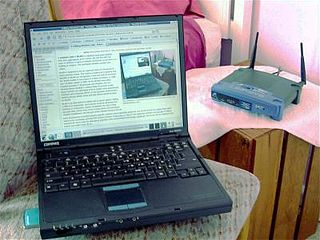Related Research Articles

IEEE 802.11 is part of the IEEE 802 set of local area network (LAN) technical standards, and specifies the set of medium access control (MAC) and physical layer (PHY) protocols for implementing wireless local area network (WLAN) computer communication. The standard and amendments provide the basis for wireless network products using the Wi-Fi brand and are the world's most widely used wireless computer networking standards. IEEE 802.11 is used in most home and office networks to allow laptops, printers, smartphones, and other devices to communicate with each other and access the Internet without connecting wires. IEEE 802.11 is also a basis for vehicle-based communication networks with IEEE 802.11p.
The ISM radio bands are portions of the radio spectrum reserved internationally for industrial, scientific, and medical (ISM) purposes, excluding applications in telecommunications. Examples of applications for the use of radio frequency (RF) energy in these bands include RF heating, microwave ovens, and medical diathermy machines. The powerful emissions of these devices can create electromagnetic interference and disrupt radio communication using the same frequency, so these devices are limited to certain bands of frequencies. In general, communications equipment operating in ISM bands must tolerate any interference generated by ISM applications, and users have no regulatory protection from ISM device operation in these bands.

Wi-Fi is a family of wireless network protocols based on the IEEE 802.11 family of standards, which are commonly used for local area networking of devices and Internet access, allowing nearby digital devices to exchange data by radio waves. These are the most widely used computer networks, used globally in home and small office networks to link devices and to provide Internet access with wireless routers and wireless access points in public places such as coffee shops, hotels, libraries, and airports.
Wireless local loop (WLL) is the use of a wireless communications link as the "last mile / first mile" connection for delivering plain old telephone service (POTS) or Internet access to telecommunications customers. Various types of WLL systems and technologies exist.

Worldwide Interoperability for Microwave Access (WiMAX) is a family of wireless broadband communication standards based on the IEEE 802.16 set of standards, which provide physical layer (PHY) and media access control (MAC) options.

The S band is a designation by the Institute of Electrical and Electronics Engineers (IEEE) for a part of the microwave band of the electromagnetic spectrum covering frequencies from 2 to 4 gigahertz (GHz). Thus it crosses the conventional boundary between the UHF and SHF bands at 3.0 GHz. The S band is used by airport surveillance radar for air traffic control, weather radar, surface ship radar, and some communications satellites, particularly satellites used by NASA to communicate with the Space Shuttle and the International Space Station. The 10 cm radar short-band ranges roughly from 1.55 to 5.2 GHz. India's regional satellite navigation network (IRNSS) broadcasts on 2.483778 to 2.500278 GHz.
IEEE 802.22, is a standard for wireless regional area network (WRAN) using white spaces in the television (TV) frequency spectrum. The development of the IEEE 802.22 WRAN standard is aimed at using cognitive radio (CR) techniques to allow sharing of geographically unused spectrum allocated to the television broadcast service, on a non-interfering basis, to bring broadband access to hard-to-reach, low population density areas, typical of rural environments, and is therefore timely and has the potential for a wide applicability worldwide. It is the first worldwide effort to define a standardized air interface based on CR techniques for the opportunistic use of TV bands on a non-interfering basis.

HomeRF was a wireless networking specification for home devices. It was developed in 1998 by the Home Radio Frequency Working Group, a consortium of mobile wireless companies that included Proxim Wireless, Intel, Siemens AG, Motorola, Philips and more than 100 other companies.
The Unlicensed National Information Infrastructure (U-NII) radio band, as defined by the United States Federal Communications Commission, is part of the radio frequency spectrum used by WLAN devices and by many wireless ISPs.

High-speed multimedia radio (HSMM) is the implementation of high-speed wireless TCP/IP data networks over amateur radio frequency allocations using commercial off-the-shelf (COTS) hardware such as 802.11 Wi-Fi access points. This is possible because the 802.11 unlicensed frequency bands partially overlap with amateur radio bands and ISM bands in many countries. Only licensed amateur radio operators may legally use amplifiers and high-gain antennas within amateur radio frequencies to increase the power and coverage of an 802.11 signal.
IEEE 802.11y-2008 is an amendment to the IEEE 802.11-2007 standard that enables data transfer equipment to operate using the 802.11a protocol on a co-primary basis in the 3650 to 3700 MHz band except when near a grandfathered satellite earth station. IEEE 802.11y is only being allowed as a licensed band. It was approved for publication by the IEEE on September 26, 2008.
Cognio, Inc. was an American company that developed and marketed radio frequency (RF) spectrum analysis products that find and solve channel interference problems on wireless networks and in wireless applications. Cognio’s Spectrum Expert product was designed for common frequency bands such as RFID and Wi-Fi. It was sold primarily to network engineers responsible for security for wireless networks or applications that run on wireless networks. Cognio was acquired by Cisco Systems in 2007.
In telecommunications, white spaces refer to radio frequencies allocated to a broadcasting service but not used locally. National and international bodies assign frequencies for specific uses and, in most cases, license the rights to broadcast over these frequencies. This frequency allocation process creates a bandplan which for technical reasons assigns white space between used radio bands or channels to avoid interference. In this case, while the frequencies are unused, they have been specifically assigned for a purpose, such as a guard band. Most commonly however, these white spaces exist naturally between used channels, since assigning nearby transmissions to immediately adjacent channels will cause destructive interference to both.
There are several uses of the 2.4 GHz ISM radio band. Interference may occur between devices operating at 2.4 GHz. This article details the different users of the 2.4 GHz band, how they cause interference to other users and how they are prone to interference from other users.
IEEE 802.11ah is a wireless networking protocol published in 2017 called Wi-Fi HaLow as an amendment of the IEEE 802.11-2007 wireless networking standard. It uses 900 MHz license-exempt bands to provide extended-range Wi-Fi networks, compared to conventional Wi-Fi networks operating in the 2.4 GHz, 5 GHz and 6 GHz bands. It also benefits from lower energy consumption, allowing the creation of large groups of stations or sensors that cooperate to share signals, supporting the concept of the Internet of things (IoT). The protocol's low power consumption competes with Bluetooth, LoRa, and Zigbee, and has the added benefit of higher data rates and wider coverage range.
IEEE 802.11af, also referred to as White-Fi and Super Wi-Fi, is a wireless computer networking standard in the 802.11 family, that allows wireless local area network (WLAN) operation in TV white space spectrum in the VHF and UHF bands between 54 and 790 MHz. The standard was approved in February 2014. Cognitive radio technology is used to transmit on unused portions of TV channel band allocations, with the standard taking measures to limit interference for primary users, such as analog TV, digital TV, and wireless microphones.
LTE in unlicensed spectrum is an extension of the Long-Term Evolution (LTE) wireless standard that allows cellular network operators to offload some of their data traffic by accessing the unlicensed 5 GHz frequency band. LTE-Unlicensed is a proposal, originally developed by Qualcomm, for the use of the 4G LTE radio communications technology in unlicensed spectrum, such as the 5 GHz band used by 802.11a and 802.11ac compliant Wi-Fi equipment. It would serve as an alternative to carrier-owned Wi-Fi hotspots. Currently, there are a number of variants of LTE operation in the unlicensed band, namely LTE-U, License Assisted Access (LAA), MulteFire, sXGP and CBRS.

Wi-Fi 6, or IEEE 802.11ax, is an IEEE standard from the Wi-Fi Alliance, for wireless networks (WLANs). It operates in the 2.4 GHz and 5 GHz bands, with an extended version, Wi-Fi 6E, that adds the 6 GHz band. It is an upgrade from Wi-Fi 5 (802.11ac), with improvements for better performance in crowded places. Wi-Fi 6 covers frequencies in license-exempt bands between 1 and 7.125 GHz, including the commonly used 2.4 GHz and 5 GHz, as well as the broader 6 GHz band.
White Space Internet uses a part of the radio spectrum known as white spaces. The frequency range is created when there are gaps between the coverage areas of television channels. The spaces can provide broadband internet access that is similar to that of 4G mobile.
References
- ↑ "Altai Technologies". www.altaitechnologies.com.
- ↑ "Case Studies – Logistics & Transportation". www.altaitechnologies.com.
- ↑ "Krysp Wireless". kryspwireless.com.
- 1 2 Sascha Segan (January 27, 2012). "'Super Wi-Fi': Super, But Not Wi-Fi". PC Magazine . Retrieved May 23, 2013.
- ↑ Dana Blankenhorn (20 September 2010). "Super WiFi solves the Google carrier problem". ZDNet . Archived from the original on September 23, 2010.
- ↑ "Super Wi-Fi Summit". Technology Marketing Corporation. Retrieved May 23, 2013.
- ↑ "IEEE 802.11af", Wikipedia, 2019-10-01, retrieved 2020-03-03
- ↑ "White-Fi IEEE 802.11af | Electronics Notes". www.electronics-notes.com. Retrieved 2020-03-03.
- ↑ Stephenson, Brad. "Your Intro to White-Fi, Super Wi-Fi, and White Space Wi-Fi". Lifewire. Retrieved 2020-03-03.
- 1 2 3 "'Super Wi-Fi' nears final approval in U.S." CBC. Associated Press. September 13, 2010. Retrieved 2021-06-04.
- ↑ Krishnan, Neelakantan Nurani; Sridharan, Gokul; Seskar, Ivan; Mandayam, Narayan (2017-04-26). "Coverage and Rate Analysis of Super Wi-Fi Networks Using Stochastic Geometry". arXiv: 1704.08152 [cs.IT].
- ↑ T. Wang, J. Wang, C. Jiang, J. Wang and Y. Ren, "Access Strategy in Super WiFi Network Powered by Solar Energy Harvesting: A POMDP Method," 2016 IEEE 83rd Vehicular Technology Conference (VTC Spring), Nanjing, 2016, pp. 1-6.
- ↑ "Krysp Wireless - Case Studies". kryspwireless.com.
- ↑ "Houston grandmother is nation's first 'Super Wi-Fi' user". PhysOrg . 19 April 2011.
- ↑ "Calgary Super Wi-Fi Network". WestNet. Retrieved 8 May 2011.
- ↑ Parrish, Kevin (27 January 2012). "First Super Wi-Fi Network in the U.S. Finally Deployed". Tom's Guide US. Retrieved 29 March 2012.
- ↑ "Nation's first campus 'Super Wi-Fi' network launches at West Virginia University". wvutoday. Retrieved 9 July 2013.
- ↑ "Super Wi-Fi Technologies" (PDF). www.microsoft.com.
- ↑ Corporation, Microsoft. "Microsoft - 4Afrika - Success Stories - Connecting The Unconnected". Microsoft - 4Afrika - Success Stories - Connecting The Unconnected. Retrieved 2021-12-29.